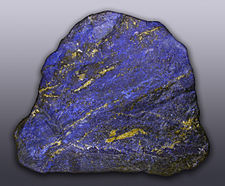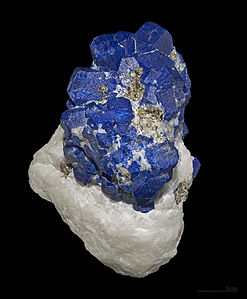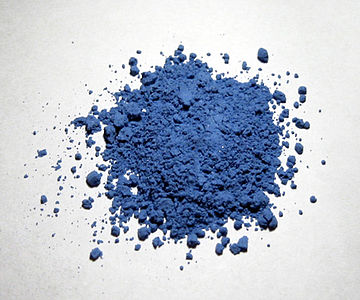
Rama [CC BY-SA 3.0 fr (https://creativecommons.org/licenses/by-sa/3.0/fr/deed.en), CC BY-SA 2.0 fr (https://creativecommons.org/licenses/by-sa/2.0/fr/deed.en) or CeCILL (http://www.cecill.info/licences/Licence_CeCILL_V2-en.html)], from Wikimedia Commons
The first time I ever heard of Lapis Lazuli was on my ninth birthday when one of my dottier aunts gave me a copy of Women in Love as a present (if you thought that was bad, I received a copy of Walden on my very next birthday). As I had not advanced far from Dan Dare’s adventures at the time, the book was a challenge to me with my mother frequently explaining some of more challenging chapters. Things went reasonably well until I came to the chapter where Hermione Roddice attacks Rupert Birkin with a piece of Lapis Lazuli. What is Lapis Lazuli? I enquired of my mother. She took me into the dining room and pointed to the rather splendid Victorian lamp that I had always liked. The beautiful blue stone which made up most of the base was indeed Lapis Lazuli and from that day onwards my love affair with the stone emerged.

By Hannes Grobe [CC BY-SA 2.5 (https://creativecommons.org/licenses/by-sa/2.5)], from Wikimedia Commons
The actual name has the ring of the exotic and broken down, Lapis is Latin for stone. Lazuli is a little more difficult being the genitive form of the Medieval latin lazulum which in turn comes from Arabic ( I never said it was going to be easy). Lapis Lazuli taken in full means Stone of Lazhward which was named after one of its original locations where deposits of the stone were first
found.
Lapis has been mined for over six thousand years and the stone has been found in many ancient sites from Egypt to the Caucasus. The actual constituents of Lapis means it is a rock and not a mineral as it contains more than one

By Didier Descouens [CC BY-SA 4.0 (https://creativecommons.org/licenses/by-sa/4.0)], from Wikimedia Commons
mineral. I am not a geologist, but my researches indicate it is a Lazurite which also contains at a lower level Soduim, Aluminum, Silicon, Sulfur, Oxygen and Chloride. The stone often contains Calcite, Sodalite and Pyrite which, as far as I can see, gives it the various veins of colour. The dominant colour is obviously blue, but it has subsequent colourings of gold (Pyrite) and white (Calcite). If the Calcite is missing and only small amounts of Pyrite are seen, then this is the most superior Lapis. This also helps to define it from dyed stone which happens when poorer strains of Lapis are found and are passed off as being of a higher grade.
One of the great things about Lapis is (as with my mothers lamp stand) that it polishes well and has many uses. From jewellery to mosaics, from vases to the uses within buildings.
I was in France a number of years ago and visited a church which had the most beautiful mosaic. In the special light of the area, the mosaic seemed to fill the corner of the church with a blue shimmering haze. It was an extraordinary sight and probably one of the major reasons why a lot of people, including myself are so attracted to the stone.
It has a type of luminosity that haunts the eye.

en:User:Rhyaxas “en:Image:Ultramarinepigment.jpg
The stone can also be ground for use in painting in both the tempara and oil mediums. Although its use in oils died out in the nineteenth century when a synthetic variety quite often alled Ultramarine came into use. It is reported that Cleopatra once used powdered Lapis as an eye shadow. It is in antiquity that one finds how much Lapis was actually used. From Egypt to Asia Minor, the stone was used in jewellery for amulets and scarabs and other ornamentation. It was indeed one of the first stones to be worn as jewellery.
In legend it is said that the city of Ur on the Euphrates dealt with large qualities of Lapis many years before the birth of Christ. It was also considered a holy stone especially in the Middle East. Alexander the Great introduced the stone to Europe (let’s hope he did not use Bucephalus who although having a blue eye, might well have objected).
As noted before, it was used in paintings and many of the Old Masters used Lapis to produce the radiant blue that even after all these years, still shows a luminosity when viewed. When these works are restored identical techniques are used. This has not changed.
There is one major advantage of using Lapis in painting and that is unlike other blue pigments, it does not fade with age. My visit to the church in Southern France confirmed this. The mosaic had been indirectly exposed to the harsh sunlight of the area for many centuries but had lost none of its colour. Indeed they complimented each other.
Although I personally do not believe in such things, Lapis is said to be the stone of truth and is said to promote harmony. I believe it is the beauty of the stone that enters the mind and because of this, the senses are stimulated.

https://www.flickr.com/photos/naomi_king/
A few years ago when off one of the Greek Islands, I experienced this. Caron was wearing a pair of Lapis earrings set in silver which glinted in the sun as the boat moved smoothly between islands. It was however the stones that really attracted my attention.
Their deep colour mirrored the colour of the late afternoon sea. We were, at that time, the only boat in the vicinity and The Rime of the Ancient Mariner came to mind.

Gustave Doré [Public domain], via Wikimedia Commons
Day after day, day after day,
We stuck nor breath nor motion;
As idle as a painted ship
Upon a painted Ocean.
This I believe was the moment when I came nearest to understanding the stone and its mysterious colours. Others will no doubt will have had similar experiences.
The common factor with Lapis Lazuli is that when you think that you have discovered her secrets, you find that she has others hidden beyond her veils of colour which she will not share.
This is the overriding mystery of the stone.